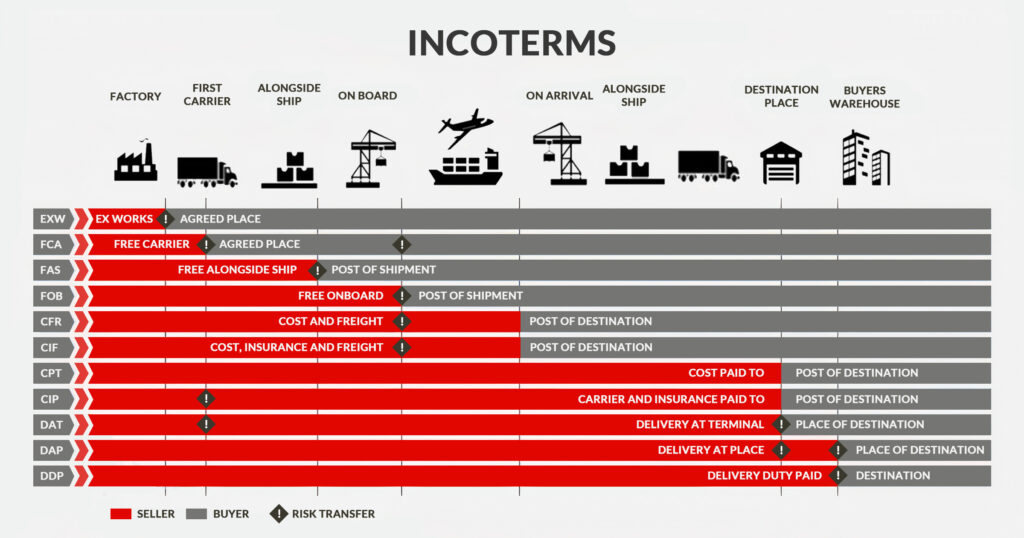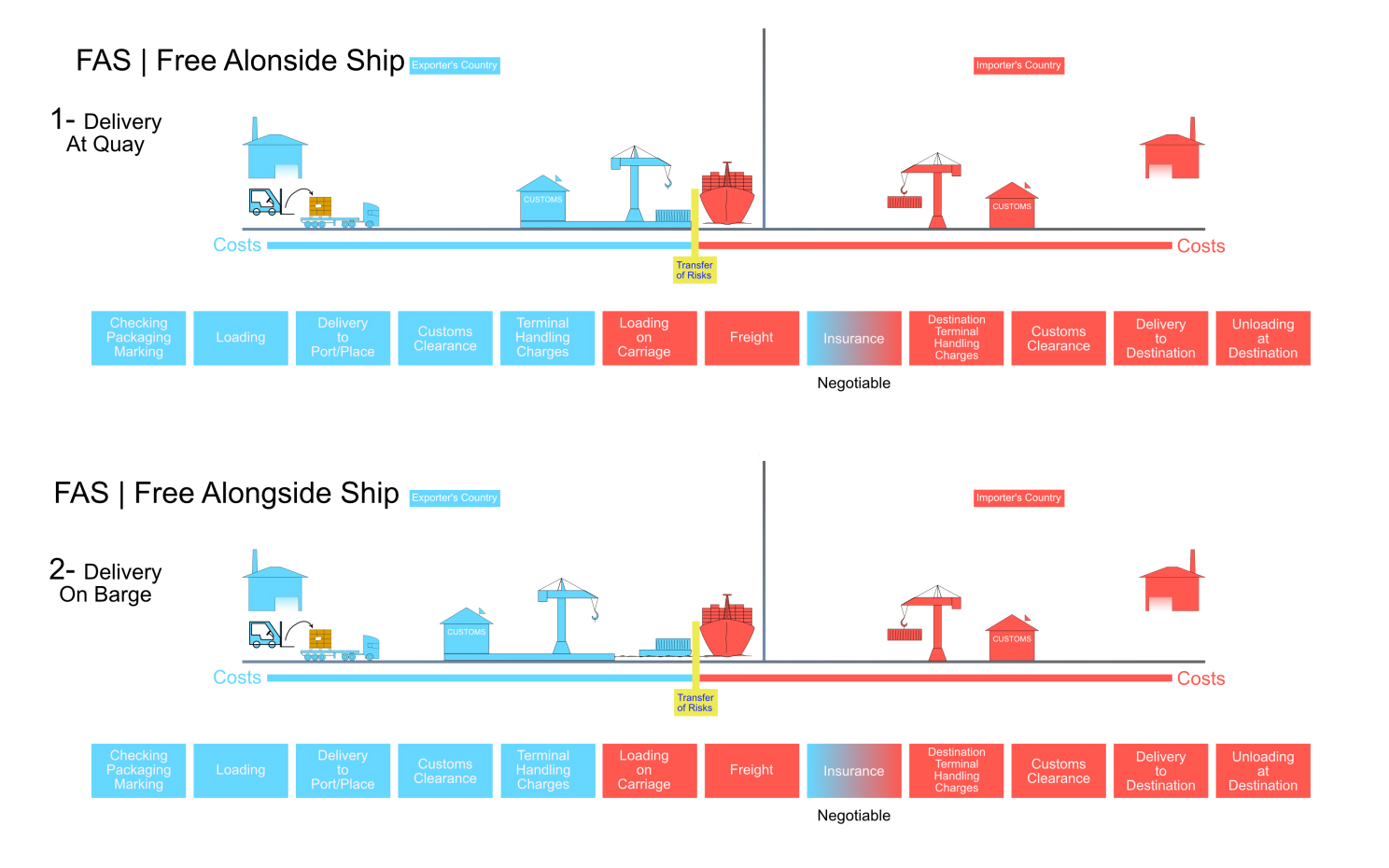Training and Terminology
Comprehensive Guide to Incoterms 2020
International Commercial Terms for Global Transport
Ettehad Holding, with the aim of enhancing the knowledge of its clients and business partners, presents this comprehensive guide to introduce Incoterms 2020. Incoterms (International Commercial Terms) are a set of standardized rules developed by the International Chamber of Commerce (ICC) that define responsibilities, costs, and risks related to the transportation and delivery of goods in global trade. The 2020 version has been in effect since January of that year and includes 11 rules applicable to various modes of transport (sea, air, land, and multimodal).

Incoterms 2020 Rules
- Description: The seller makes the goods available at their premises (factory or warehouse). The buyer bears all costs and risks.
• Usage: Suitable for buyers seeking full control of the transport.
• Responsibilities:
o Seller: Prepares the goods.
o Buyer: Loading, transport, insurance, and customs clearance.
• Note: Minimum responsibility for the seller.
- Description: The seller delivers the goods to the carrier or a location designated by the buyer. Risk transfers after delivery.
• Usage: Suitable for multimodal transport.
•Responsibilities:
o Seller: Delivery to carrier and export clearance.
o Buyer: Freight, insurance, and import clearance.
• 2020 Change: Seller can now request a bill of lading.

• Description: The seller delivers the goods alongside the ship at the port of origin. The buyer is responsible for loading.
• Usage: Specific to non-containerized sea transport.
• Responsibilities:
o Seller: Delivery alongside the ship and export clearance.
o Buyer: Loading, transport, and insurance.

• Description: The seller loads the goods on board the ship at the port of origin. Risk transfers after loading.
• Usage: Non-containerized sea transport.
• Responsibilities:
o Seller: Loading and export clearance.
o Buyer: Transport, insurance, and import clearance.

• Description: The seller pays the transport cost to the port of destination, but risk transfers after loading.
• Usage: Non-containerized sea transport.
• Responsibilities:
o Seller: Freight and export clearance.
o Buyer: Insurance, unloading, and import clearance.

• Description: Same as CFR, but the seller also provides minimal insurance (110% of goods’ value).
• Usage: Non-containerized sea transport.
• Responsibilities:
o Seller: Freight, insurance, and export clearance.
o Buyer: Unloading and import clearance.

• Description: The seller pays freight to the destination, but risk transfers upon delivery to the carrier.
• Usage: All modes of transport.
• Responsibilities:
o Seller: Freight and export clearance.
o Buyer: Insurance, unloading, and import clearance.

- Description: Similar to CPT, but the seller provides more comprehensive insurance.
• Usage: All modes of transport.
• Responsibilities:
o Seller: Freight, comprehensive insurance, and export clearance.
o Buyer: Unloading and import clearance.
• 2020 Change: Requirement for more extensive insurance coverage.

• Description: The seller delivers goods at the agreed place of destination (unloading not included).
• Usage: All modes of transport.
• Responsibilities:
o Seller: Transport and export clearance.
o Buyer: Unloading and import clearance.

• Description: The seller delivers goods at the agreed place of destination, already unloaded.
• Usage: All modes of transport.
• Responsibilities:
o Seller: Transport, unloading, and export clearance.
o Buyer: Import clearance.
• 2020 Change: Replaces DAT, with delivery possible at any location.

- Description: The seller is responsible for all obligations (transport, insurance, customs clearance) up to the destination.
• Usage: For buyers seeking minimum responsibility.
• Responsibilities:
o Seller: Transport, insurance, and customs clearance.
o Buyer: Receiving the goods.

Key Changes in Incoterms 2020
- DPU replaces DAT: Delivery can be at any location, not just terminals.
• CIP Insurance: More comprehensive insurance is now mandatory.
• FCA and Bill of Lading: Sellers can now obtain on-board bills of lading.
• Cost Transparency: More detail in clauses A9/B9.
• Transport Security: New security requirements introduced.
Practical Tips for Using Incoterms
• Specify Version and Place: In contracts, clearly state the version (e.g., Incoterms 2020) and the exact place (e.g., FCA Shanghai).
• Choose the Right Rule: Select the rule appropriate for your goods and mode of transport.
• Proper Insurance: Under CFR and CPT, the buyer must arrange insurance.
• Professional Advice: Work with freight forwarders or customs advisors.
Incoterms 2020 Summary Table
Rule | Mode of Transport | Delivery Point | Seller’s Responsibility | Buyer’s Responsibility |
EXW | All Modes | Seller’s Premises | Preparing goods | Transport, insurance, customs |
FCA | All Modes | To Carrier | Delivery to carrier, export clearance | Transport, insurance, customs |
FAS | Sea | Alongside Ship | Delivery alongside ship, export clearance | Loading, transport, insurance |
FOB | Sea | On Board Ship | Loading, export clearance | Transport, insurance, customs |
CFR | Sea | Destination Port | Freight, export clearance | Insurance, unloading, customs |
CIF | Sea | Destination Port | Freight, insurance, export clearance | Unloading, customs |
CPT | All Modes | Destination | Freight, export clearance | Insurance, unloading, customs |
CIP | All Modes | Destination | Freight, comprehensive insurance, export clearance | Unloading, customs |
DAP | All Modes | Destination | Transport, export clearance | Unloading, customs |
DPU | All Modes | Destination (Unloaded) | Transport, unloading, export clearance | Customs |
DDP | All Modes | Destination | Transport, insurance, customs clearance | Receiving goods |


Importance of Incoterms 2020
Incoterms help simplify commercial contracts and prevent disputes arising from legal and linguistic differences. Key benefits include:
• Clarity: Clearly defines the responsibilities of the buyer and seller.
• Risk Reduction: Prevents misunderstandings in international transactions.
• Global Acceptance: Widely used by traders, carriers, and customs authorities.
• Flexibility: Suitable for all modes of transport.
Incoterms 2020 Classification
Incoterms 2020 are divided into four groups: